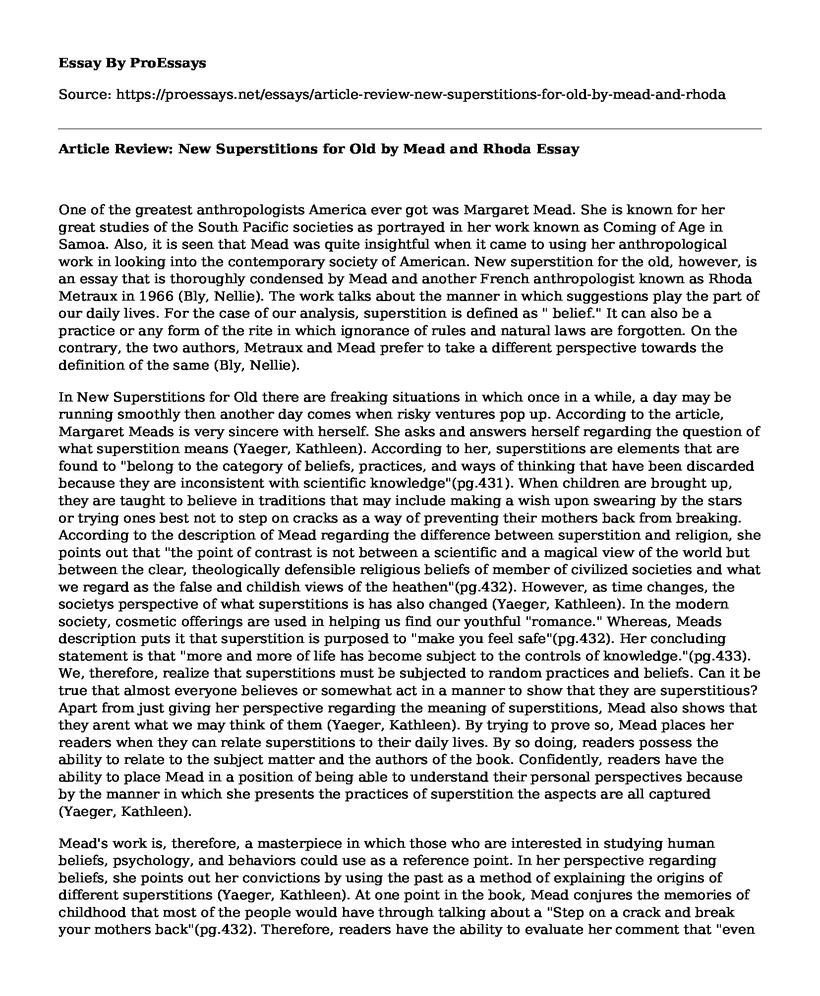One of the greatest anthropologists America ever got was Margaret Mead. She is known for her great studies of the South Pacific societies as portrayed in her work known as Coming of Age in Samoa. Also, it is seen that Mead was quite insightful when it came to using her anthropological work in looking into the contemporary society of American. New superstition for the old, however, is an essay that is thoroughly condensed by Mead and another French anthropologist known as Rhoda Metraux in 1966 (Bly, Nellie). The work talks about the manner in which suggestions play the part of our daily lives. For the case of our analysis, superstition is defined as " belief." It can also be a practice or any form of the rite in which ignorance of rules and natural laws are forgotten. On the contrary, the two authors, Metraux and Mead prefer to take a different perspective towards the definition of the same (Bly, Nellie).
In New Superstitions for Old there are freaking situations in which once in a while, a day may be running smoothly then another day comes when risky ventures pop up. According to the article, Margaret Meads is very sincere with herself. She asks and answers herself regarding the question of what superstition means (Yaeger, Kathleen). According to her, superstitions are elements that are found to "belong to the category of beliefs, practices, and ways of thinking that have been discarded because they are inconsistent with scientific knowledge"(pg.431). When children are brought up, they are taught to believe in traditions that may include making a wish upon swearing by the stars or trying ones best not to step on cracks as a way of preventing their mothers back from breaking. According to the description of Mead regarding the difference between superstition and religion, she points out that "the point of contrast is not between a scientific and a magical view of the world but between the clear, theologically defensible religious beliefs of member of civilized societies and what we regard as the false and childish views of the heathen"(pg.432). However, as time changes, the societys perspective of what superstitions is has also changed (Yaeger, Kathleen). In the modern society, cosmetic offerings are used in helping us find our youthful "romance." Whereas, Meads description puts it that superstition is purposed to "make you feel safe"(pg.432). Her concluding statement is that "more and more of life has become subject to the controls of knowledge."(pg.433). We, therefore, realize that superstitions must be subjected to random practices and beliefs. Can it be true that almost everyone believes or somewhat act in a manner to show that they are superstitious? Apart from just giving her perspective regarding the meaning of superstitions, Mead also shows that they arent what we may think of them (Yaeger, Kathleen). By trying to prove so, Mead places her readers when they can relate superstitions to their daily lives. By so doing, readers possess the ability to relate to the subject matter and the authors of the book. Confidently, readers have the ability to place Mead in a position of being able to understand their personal perspectives because by the manner in which she presents the practices of superstition the aspects are all captured (Yaeger, Kathleen).
Mead's work is, therefore, a masterpiece in which those who are interested in studying human beliefs, psychology, and behaviors could use as a reference point. In her perspective regarding beliefs, she points out her convictions by using the past as a method of explaining the origins of different superstitions (Yaeger, Kathleen). At one point in the book, Mead conjures the memories of childhood that most of the people would have through talking about a "Step on a crack and break your mothers back"(pg.432). Therefore, readers have the ability to evaluate her comment that "even in the most sophisticated home, something is likely to happen that evokes the memory of some old folk belief"(pg.431). In her mindset, superstitions can be compared to "transitional objects" which she explains that help "people pass between areas of life where sequences of events are explicable regarding cause and effect, based on knowledge"(pg.433).
One can easily conform to the fact that the essay written by Mead and Rhoda is well structured and organized. It has an introductory part that is engaging enough, a body well summarized plus several examples that aid the support of her thesis, and a conclusion that provide readers with a definite ending (Yaeger, Kathleen). In conclusion, Mead showcases a happy thought which suggests that superstitions have the ability to help humans keep some segments of their lives which she terms as "a private world"(pg.433). According to Mead, this private world is anywhere that humans have the capability of pretending that such places can control their lives (Yaeger, Kathleen).
Work Cited
Bly, Nellie. "Margaret Mead." Biography.Com, 2014, http://www.biography.com/people/margaret-mead-9404056.
Yaeger, Kathleen. "Student Rhetorical Analysis." Web.Cocc.Edu, 2013, http://web.cocc.edu/cagatucci/classes/wr121/fall2002/rhetorical_analysis.htm.
Cite this page
Article Review: New Superstitions for Old by Mead and Rhoda. (2021, Jun 14). Retrieved from https://proessays.net/essays/article-review-new-superstitions-for-old-by-mead-and-rhoda
If you are the original author of this essay and no longer wish to have it published on the ProEssays website, please click below to request its removal:
- Should Drug Abuse Moms Be Granted Custody of Their Infants After Birth: The Ethical Issue
- Essay Sample on Management Styles for Teams
- Essay Sample on Capitalism and Race
- Essay Sample on Interpersonal Relationship Analysis
- Essay Example on Privatizing Child Welfare: Exploring CBC for Foster Children in Florida
- Free Report Example on Communication Challenge
- Essay Sample: Exploring Ethical Dimensions in Technical Communication and Workplace Leadership







